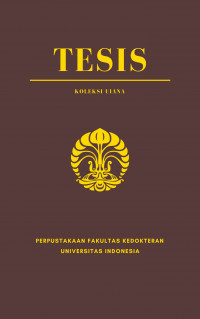Tesis
Efek Penggunaan Graft Kartilago Aurikular Terhadap Kedalaman Forniks dan Volume Soket pada Rekonstruksi Soket Mengerut dan Pengaruhnya Terhadap Kualitas Hidup Pasien: Studi Pendahuluan = Effect of Auricular Cartilage Graft Application on Fornix Depth and Socket Volume in Contracted Socket Reconstruction and the Impact on Patient Quality of Life: a Preliminary Study.
Latar Belakang: Kelainan soket mengerut merupakan salah satu kasus rekonstruksi mata yang sering dijumpai. Kelainan ini menyebabkan protesa mata tidak dapat dipasang sehingga dapat menyebabkan penurunan produktivitas yang berdampak pada kualitas hidup pasien. Rekonstruksi soket mengerut dapat dilakukan menggunakan berbagai materi autogenous graft, namun graft kartilago aurikular dinilai lebih kuat dan lebih tahan lama. Tujuan: Menilai peran penggunaan graft kartilago aurikular pada rekonstruksi soket mengerut derajat ringan - sedang, baik secara objektif maupun subjektif. Metode: Penelitian prospektif ini merupakan penelitian quasi eksperimental dengan membandingkan sampel sebelum dan sesudah perlakuan. Pasien dengan kelainan soket mengerut derajat ringan-sedang dengan riwayat protesa mata terlepas akan dilakukan rekonstruksi menggunakan graft kartilago aurikular. Dilakukan pemeriksaan soket secara objektif pada pasien sebelum dan sesudah dilakukan intervensi hingga 8 minggu pascaoperasi, berupa kedalaman forniks inferior, volume soket, dan epitelisasi konjungtiva. Secara subjektif, kualitas hidup pasien dinilai menggunakan kuesioner WHOQOL-BREF sebelum dan sesudah rekonstruksi. Hasil: Rekonstruksi menggunakan graft kartilago aurikular dilakukan pada 12 pasien (rerata usia 47,7±0,1 tahun). Didapatkan perubahan kedalaman forniks inferior sebelum intervensi 1 - 5 mm (2,75±1,1 mm) menjadi 4 - 9 mm (7,17±1,5 mm) setelah 8 minggu pascaoperasi (p < 0,001). Volume soket pada awal kedatangan 0,2-0,6 ml (0,45±0,1 ml) meningkat menjadi 0,7 - 1,1 ml (0,87±0,1 ml) pada minggu ke-8 pascaoperasi (p < 0,001). Epitelisasi lengkap terlihat pada seluruh subjek di minggu ke-8. Kualitas hidup pasien dinilai mengalami peningkatan signifikan (p < 0,001) pada seluruh domain dengan skor melebihi 65% pasca rekonstruksi. Kesimpulan: Penggunaan graft kartilago aurikular pada rekonstruksi soket mengerut menunjukkan peningkatan yang signifikan dengan rerata selisih pada kedalaman forniks inferior 4,42±1,2mm dan volume soket 0,42±0,2ml. Epitelisasi konjungtiva terjadi lengkap pada seluruh pasien penelitian di minggu ke-8. Tidak ada morbiditas pada area donor. Secara subjektif, pasien mengalami peningkatan kualitas hidup yang bermakna pada aspek kesehatan fisik, psikologis, hubungan sosial, dan lingkungan.
Kata Kunci: Soket Anoftalmia Mengerut; Graft Kartilago Aurikular; Rekonstruksi Soket Mengerut
Background: A contracted socket is one of the most common ocular reconstruction cases. This abnormality causes prosthetic eye cannot be attached, leading to decreased productivity which affects the patient's quality of life. Contracted socket reconstruction can be performed with various autogenous graft materials, although auricular cartilage graft provides greater support and longer durability. Objective: To assess auricular cartilage graft application in mild to moderate degree of contracted socket reconstruction, both objectively and subjectively. Methods: This prospective study was a quasi-experimental study using a comparison of the sample before and after an intervention. Patients with a contracted socket of mild to moderate degree with a history of prosthetic eye detachment were reconstructed using auricular cartilage graft. Objective assessments, such as inferior fornix depth, socket volume, and epithelization, were done before and after the surgery until eight weeks postoperative. Subjectively, the patient's quality of life was observed using the WHOQOL-BREF questionnaire before and after the reconstruction. Result: Reconstruction using auricular cartilage graft was performed in 12 patients (mean age 47,7 0,1 years). This study found inferior fornix depth changed from 1 - 5 mm (2,751,1 mm) pre-operative to 4 - 9 mm (7,171,5 mm) 8 weeks after surgery (p < 0,001). Socket volume increased from 0,2-0,6 ml (0,450,1 ml) in pre-operative assessment to 0,7 - 1,1 ml (0,870,1 ml) in 8-week follow up (p < 0,001). Complete epithelization was seen in all subjects after 8 weeks period. Patient's quality of life showed significant increase (p < 0,001) in all domain with score exceeding 65% after reconstruction. Conclusion: Auricular cartilage graft application in contracted socket showed a significant increase with a mean difference of inferior fornix depth 4,42±1,2mm and socket volume 0,42±0,2ml. Complete conjunctival epithelization was seen in all patients on the eighth week. No morbidity was found in the donor area. Subjectively, patients showed a significant increase in quality of life from physical health, psychological, relationship, and environmental aspects.
Keywords: Anophthalmic Contracted Socket; Auricular Cartilage Graft; Contracted Socket Reconstruction
- Judul Seri
-
-
- Tahun Terbit
-
2021
- Pengarang
-
Claudia Hartomuljono - Nama Orang
Levina Chandra - Nama Orang
Yunia Irawati - Nama Orang - No. Panggil
-
T21436fk
- Penerbit
- Jakarta : Program Studi Ilmu Kesehatan Mata., 2021
- Deskripsi Fisik
-
xv, 90 hal; ill; 21 x 30 cm
- Bahasa
-
Indonesia
- ISBN/ISSN
-
-
- Klasifikasi
-
NONE
- Edisi
-
-
- Subjek
- Info Detail Spesifik
-
Tanpa Hardcopy
| T21436fk | T21436fk | Perpustakaan FKUI | Tersedia |


Masuk ke area anggota untuk memberikan review tentang koleksi